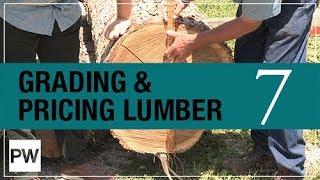
Milling Your Own Lumber - Part 7: Grading & Pricing
Тэги:
#Popular #Woodworking #woodmizer #milling #lumber #grading #pricingКомментарии:

Very knowledgeable. Thanks guys.
Ответить
What a truly awesome small series. This was spectacular. Lots of great info. Suprized it's not on TV. Thank you so much for making this!
Ответить
I truly enjoy listening to someone that really knows what they are talking about. That older fella has obviously worked hard in his industry to become the very knowledgeable person that he has become. Very informative and interesting. Thank you for sharing your wealth of knowledge. I greatly appreciate it.
Ответить
Watching this series has helped me to understand just why lumber is so expensive.
Ответить
Loved this helpful info, thank you for doing it. Question: How do we know what different species are worth, such as noble fir or juniper timber? Ive found we have acess to timber thst isnt sold in mass quantity in stores, but seems like we could still use it for home building, interior work, or furniture. Ive heard Juniper is even superior to cedar for lasting outdoors without treating it for things like pergolas, raised beds, etc. Ive wondered about for wood siding or roofing shingles as well. We also cut giant cottonwood but my husband said its worthless and we cant use it for anything (but he said the same thing about our black walnut trees! 😂). Is it correct cottonwood doesnt have any use for building of any kind or flooring etc? ?
How do i find this information for different species? Thank you so much.

excellent training. amazing. he's so knowledgeable.
Ответить
My family recently sold 181 trees that according to the timber guy has 51,000 board feet.
I have a very bitter distant VERY distant relative who is upset we didn't go through him. He claims we're being cheated even though I've never told him the price we're getting.
He says they are taking all our high value trees. Walnut, Red Oak, and I know they are taking Beech too. The timber guys we went through do their own milling.
Can anyone tell me how much on average 51,000 board feet is worth? I don't know how many of each species they are taking.
Also I know for a fact that they aren't taking ALL of our walnut and oak tree. A neighbor we trust walked the woods with the Forester guy and for every walnut they marked they left at least 3. They said we will have more to harvest in 10yrs.

Great Series! Thank you.
Ответить
Thanks. Does #2 and better has same quality attributes of #1?
Ответить
Outstanding series. I have learned so much!
Ответить
So helpful gents, thanks!
Ответить
Dan , thanks for taking the time to pass on knowledge. God bless.
Ответить
very informative. Much appreciated
Ответить
And 3 common
Ответить
White oak is graded well at the mill I work at, 1 BTR, 2-3A R and 2-3A
Ответить
Great series. Just binged through it all in one sitting lol. I've got a small mill coming in 9 weeks, more for personal needs, but I'm sure people will some services from it. Looking forward to seeing more of your content!
Ответить
Wow. He's learned a lot over the years, probly made some mistakes along thd way too, honestly mistakes are an opportunity to learn it may cost you money but so does school.
Its just more a diy classroom.
Id like to know what he thinks about the proper way to store wood inside a tempture controlled environment like a basement thats been possessed and milled on a planer .
And really as a novice woodworker I dont think there is any bad lumber as it all can be used for somthing.
Lol one time at the lumber yard they had a kiln dried 2x4 that was twisted and warped by feet not inches. I think you could have made a coat rack with it. I think it was Douglass fur or some kind of pine. This 2x4 was so bad it was a conversion piece. I guess its the imitation you put into it for what it is.
Thats why less then perfect lumber is popular now. And lumber you've have cleaned up 40 years ago as trash fetches a good price in value now.

I wish I had this gentleman's knowledge, he is amazing!
Ответить
Doyle scale cheats timber sellers, because it uses a 5/16” blade kerf that no one uses today, and it greatly underestimates volume on logs that are not the giant virgin growth of 1825, when Doyle was created. The reason all the mills use Doyle is because they’re all equally cheating timber sellers. Think about this, would you rather use a measurement system invented at the beginning of the industrial revolution, or one invented almost 200 years later? Ummmm I’d rather use the International scale, please. Even International is not totally accurate, because most logs today are cut on bandsaws, which have a 1/8” kerf, literally half of the 1/4” rule used in International. That means there’s half the waste that’s figured into how much wood a log will produce. That means more wood coming from the sawmill, and more money in the mill’s pocket. The worst situation is when log buyers use Doyle for veneer logs, where there’s zero blade waste, and therefore no reduction in expected volume from sawing waste. Land owners and foresters need to push back and demand fair treatment
Ответить
Great series, thanks!
Ответить
Highly informative. I am getting schooled on timber by your videos.
Ответить
Excellent information. Thanks for sharing.
Ответить
Awesome series with great information.
Ответить
😍😍😍
Ответить
I`m getting close to 80 & didn`t suspect some of that & I grew up in the hills of central Mo Don`t know if I will ever use it but interesting
Ответить
Wow, this is a great learning experience! Thank you so much for sharing this information with us.
Ответить
The man has a terrible shake with his right hand. What's wrong ?
Ответить
PW thank you for doing this series! Well done! It's nice to hear from experts in the field. I am fairly new to milling, and this was very helpful! A follow-up series going even deeper would be awesome!
Ответить

























